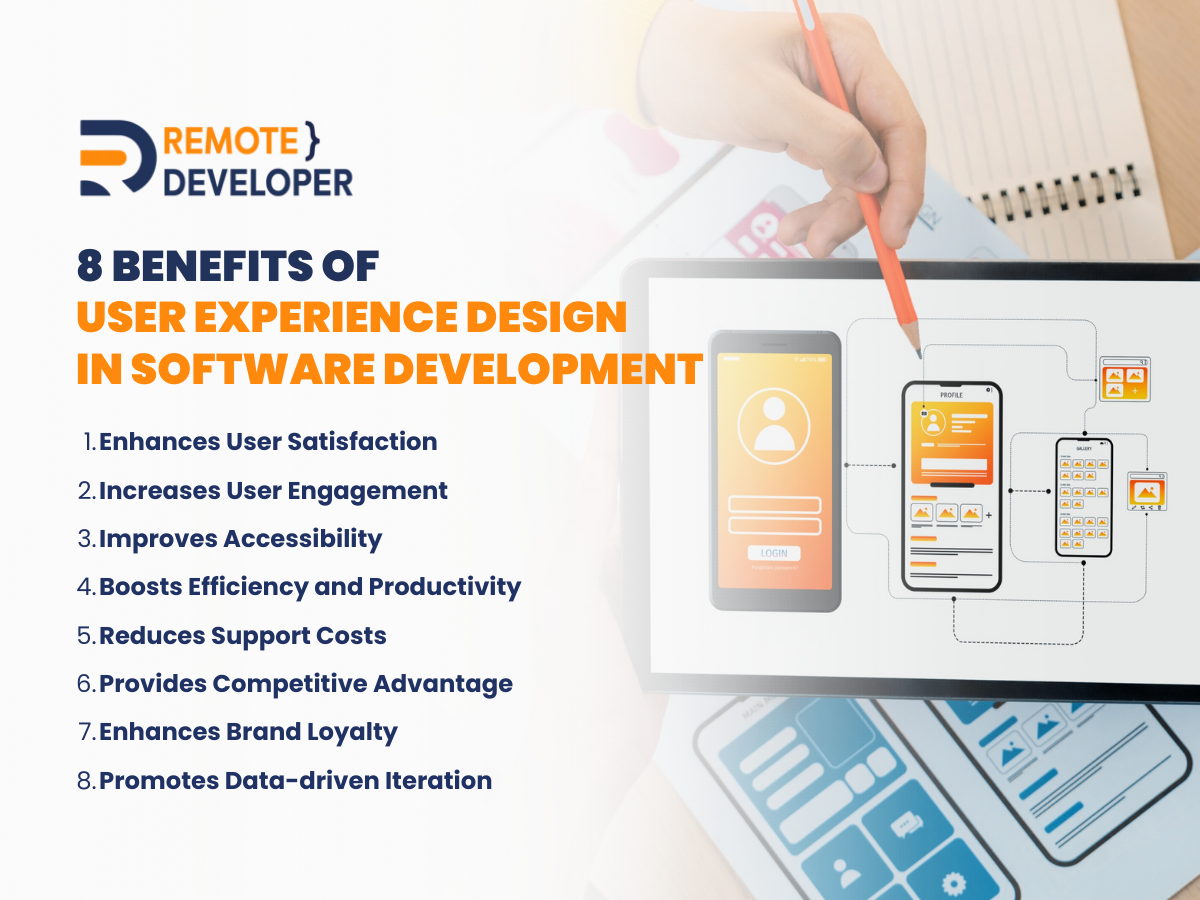Have you ever found yourself frustrated by clunky and confusing software? If yes, then you are not alone! Many of us have probably used poorly designed software that confuses us and interferes with productivity. And in today’s digital age, this is a big no-no.
User experience plays a significant role in creating meaningful and enjoyable interactions between users and software. This aspect is essential in determining the success of your software. After all, a positive user experience fosters satisfaction and loyalty among users.
So, in this article, we will delve into the importance of UX design in software development, exploring how it influences user satisfaction, product adoption, and, ultimately, the success of software ventures in today’s competitive market.
What is User Experience (UX)?
User experience, often abbreviated as UX, refers to a user’s overall experience while interacting with a product, website, or software application. It encompasses the user’s perceptions, emotions, and behavioural responses.
Basically, the main goal of UX design is to create user-friendly, intuitive, and visually appealing interfaces that enhance the overall experience. It focuses on understanding user needs, behaviour, and preferences to design products that meet their needs. Successful UX design should have all user interaction aspects, including usability, accessibility, and visual design.
What is the role of UX in software development?
User experience design plays a pivotal role in software development. Primarily, it aligns software features with user needs, ensuring that it’s user-friendly and optimised for user interactions. Similarly, it encompasses a variety of critical functions throughout the lifecycle of software, including:
- Designing Intuitive Interfaces. UX designers focus on creating interfaces that are intuitive and user-friendly by employing principles of usability and accessibility. They ensure users can easily navigate the software without frustrations.
- Improving Usability and Efficiency. UX design is crucial in optimising software applications’ usability and efficiency. Designers streamline workflows, reduce cognitive load, and eliminate unnecessary friction points.
- Promoting Accessibility and Inclusivity. UX designers advocate for accessibility and inclusivity in software development. They ensure that products are usable by individuals of all abilities and backgrounds.
- Collaboration with Cross-functional Teams. UX professionals collaborate closely with product managers, developers, and other stakeholders throughout the software development process. They integrate user-centric design principles into cross-functional teams and ensure the final product meets user needs.
8 Benefits of User Experience Design in Software Development
As mentioned earlier, UX design is crucial in software development as it offers numerous benefits for both users and developers. To further expound, here are eight (8) key benefits of UX design in software development.

Enhances User Satisfaction
User satisfaction is a critical factor in the success of any software product. Firstly, users are likelier to adopt and continue using software that offers a great user experience. This leads to higher user engagement, increased customer loyalty, and positive word-of-mouth recommendations. Additionally, user satisfaction is crucial in driving user retention, as satisfied users are less likely to switch to a competitor’s product.
With that said, one of the most vital benefits of User Experience Design is its ability to ensure user satisfaction. UX design ensures that software is easy to use and intuitive. And when users find the software easy to use and navigate, they are more likely to have a positive experience, increasing user satisfaction.
Increases User Engagement
Along with this, user engagement is one of the top benefits of User Experience Design. UX design focuses on creating user interfaces that are visually appealing and easy to interact with. An intuitive user interface is critical to facilitating user engagement, as users can quickly and effortlessly navigate through the software, find desired information, or perform desired tasks.
In this case, engaging software encourages users to keep coming back. This can result in increased usage, longer average session durations, and a higher likelihood of users recommending the software to others.
Improves Accessibility
Accessibility is an essential consideration in user experience design. It refers to designing software accessible to a broader range of users, including those with disabilities. Considering accessibility during the design process leads to better overall user experiences, reduces legal risks, and enhances a company’s reputation for inclusivity.
Having said that, one of the key benefits of User Experience Design is ensuring that individuals with visual, auditory, physical, or cognitive impairments use the software.
Boosts Efficiency and Productivity
Without a doubt, one of the vital benefits of User Experience Design is that it boosts efficiency and productivity. UX Design optimises workflows, removes unnecessary steps, and simplifies user interaction. This improves the overall efficiency and productivity of users.
In the development process, well-designed software reduces user errors and minimises the time spent correcting them, leading to improved efficiency. Moreover, UX involves gathering user feedback and understanding user needs, which informs design decisions and leads to more efficient software development. design
Reduces Support Costs
One of the crucial benefits of User Experience Design is that it lowers support costs. Good UX design reduces the need for customer support, as users are more likely to find software intuitive and require less assistance. Users will spend less time understanding or using software, thereby reducing support needs.
Provides Competitive Advantage
In today’s competitive market, user experience design provides a significant competitive advantage. Software developers can differentiate their products from competitors and attract and retain users. After all, well-designed software that offers excellent user experiences stands out from the competition and attracts users.
On another point, user experience design involves conducting market research to understand user needs, preferences, and pain points. This research enables software developers to create products that better meet user needs, giving them a competitive advantage.
Enhances Brand Loyalty
It should also be noted that one of the essential benefits of user experience design is brand loyalty. In a crowded marketplace, brand loyalty can serve as a powerful differentiator. Software companies with a strong base of loyal customers may have a competitive edge over rivals as they benefit from customer retention and positive brand perception.
With that said, UX design prioritises user needs, preferences, and pain points, resulting in positive user experiences. Software that meets user needs and provides a seamless journey fosters brand loyalty.
Promotes Data-driven Iteration
Last but not least, data-driven iteration. UX design involves conducting user research and gathering data on user needs, preferences, and pain points. This data drives design decisions and facilitates ongoing iteration. Moreover, software developers can make informed design decisions with this data and continually enhance the user experience.
To add up, UX design involves leveraging analytics tools and user behaviour data to gain insights into user interactions, engagement, and satisfaction. This data helps identify areas of improvement and informs design decisions.
Conclusion
In conclusion, user experience design plays a vital role in software development. It is the cornerstone of creating products that not only meet user needs but also exceed expectations, driving satisfaction, loyalty, and, ultimately, success in the marketplace.
So, what are you waiting for? Take your software development to the next level with superior user experience design! Contact us today to learn how our expert team can help enhance your product’s usability and success!

